Maintaining proper tire inflation is relatively simple and essential to the overall tire performance of your vehicle. A properly inflated tire will provide longer life, quicker steering response, better fuel efficiency and a smoother ride than an improperly inflated tire. Both underinflation and overinflation can cause headaches like premature treadwear and possible tire failure. The best way to ensure you're getting the most out of your tires is to check your tire pressure on a monthly basis.
Knowing how to use a tire pressure gauge is very simple. Here’s how to check tire pressure and refill your tires.
Items You Need When Checking Tire Pressure
Tire pressure gauge
Air compressor
Pen and paper
Your tire pressure gauge can be digital or standard. Auto parts stores typically carry both. Many auto parts stores sell portable air compressors that run from your car battery or 12v power port. Alternatively, you can use the air compressor found at most gas stations. They usually cost $0.50 or $1.00 to use.
Vehicle manufacturers specify PSI – literally “pounds per square inch” of pressure – assuming tires are cold. Tires are considered cold when the vehicle has been parked for three hours or more, or if the vehicle has been driven less than a mile (1.6 km) at moderate speed. PSI is the unit your pressure gauge uses to provide readings.
Look on the driver’s side door jamb or your owner’s manual to find the recommended cold tire PSI for your front and rear tires. If you cannot find it, you should consult your vehicle dealer, manufacturer, or a qualified tire professional.
If your front and rear tires require different pressure levels, write down the correct PSI for each to avoid getting confused as you move around your vehicle checking tire pressure.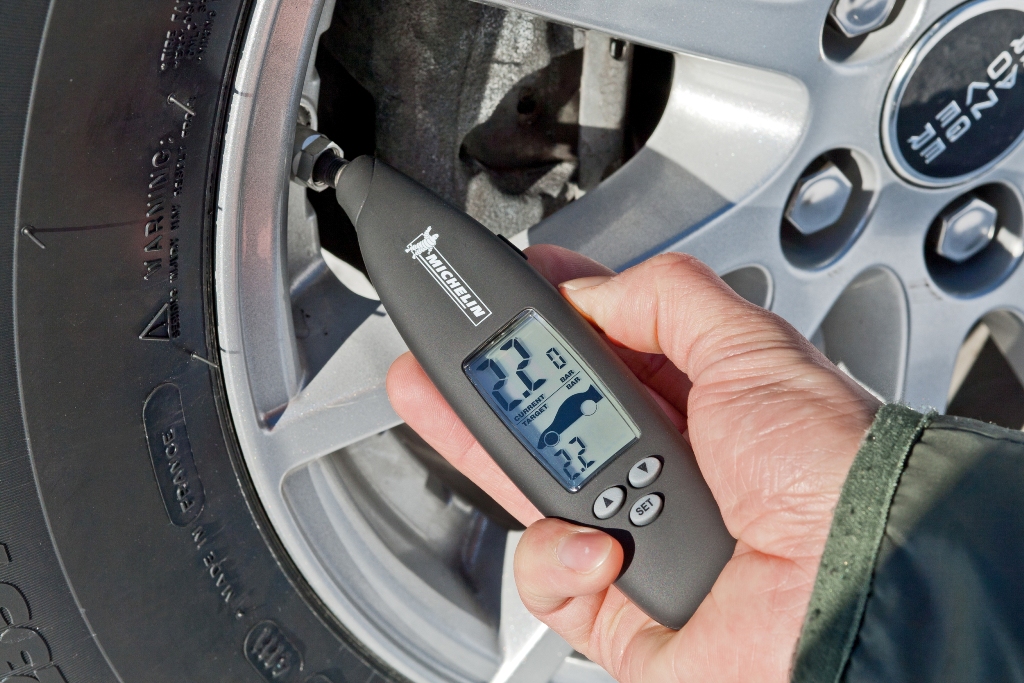
Remove the valve cap from one of your tires. Then place the pressure gauge on the valve stem and press down hard enough so the hiss sound disappears and your gauge provides a reading. With a standard gauge, the air pressure will push a small bar out from the bottom of the gauge. Measurement units are etched into the bar. A digital gauge will show you the reading on a screen.
Write down the reading and repeat this process for all four tires.
Use an air compressor to refill any tires with low pressure. Many air compressors are different, so read directions carefully to be sure you’re using it correctly.
If you’re using the air compressor at a gas station, be sure to park so that the hose will reach all four tires. Insert change into the machine until you hear the motor running. Fill each tire by placing the end of the hose over the valve stem and pressing on the lever.
Using a gas station air compressor means your tires might be “hot.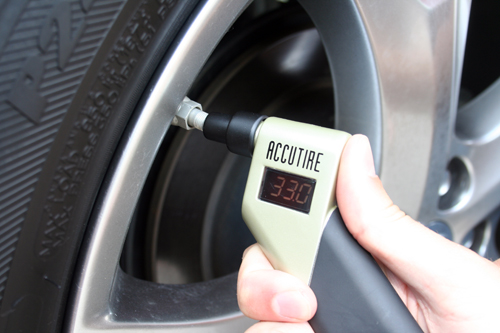 ” If it is necessary to adjust inflation pressure when tires are “hot”, set their pressure to 4 psi (14 kPa) above the recommended cold inflation pressure. Recheck the inflation pressure when the tires are cold.
” If it is necessary to adjust inflation pressure when tires are “hot”, set their pressure to 4 psi (14 kPa) above the recommended cold inflation pressure. Recheck the inflation pressure when the tires are cold.
After filling your tires, use the gauge to check pressure again. At this point, it’s ok if you overfilled the tires because you can always let some air back out. Never drive on overinflated tires. Overinflation can result in decreased traction, premature wear, and decreased impact absorption.
Make the above procedure a monthly ritual. Regularly checking your tire pressure is the best way to ensure your tires never dip far below the optimal PSI.
Accuracy matters and you should keep that in mind when choosing a gauge. For just a few dollars, you can find a quality, accurate tire pressure gauge that gives accurate readings. If you’re not sure which one to purchase, ask a professional technician which he or she prefers.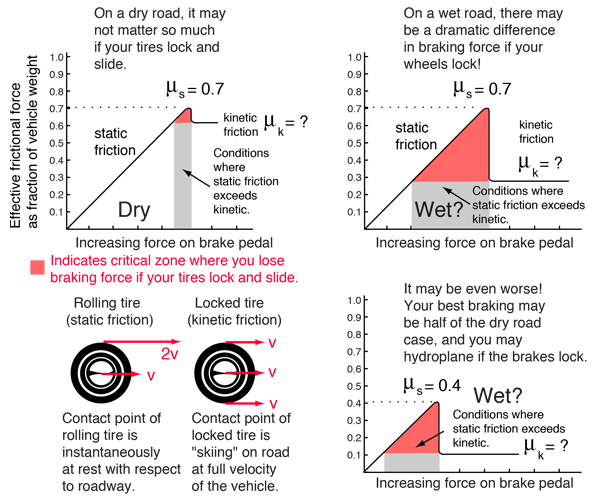
A digital tire pressure gauge will provide accurate readings, but don’t forget that it operates on a battery. If you think having to replace the battery will prevent you from using it, it’s best to go with a standard gauge.
It’s best to use your personal tire gauge versus those available attached to air hoses at service stations. Of all the pressure gauges out there, they’re the most likely to be weathered, and possibly inaccurate.
There’s never a good time for a flat. That’s why Bridgestone DriveGuard tires are masterfully engineered to keep you moving for up to 50 miles at speeds up to 50 MPH without disruption.
There’s never a good time for a flat. That’s why Bridgestone DriveGuard tires are masterfully engineered to keep you moving for up to 50 miles at speeds up to 50 MPH without disruption.
See Details Find Your Fit
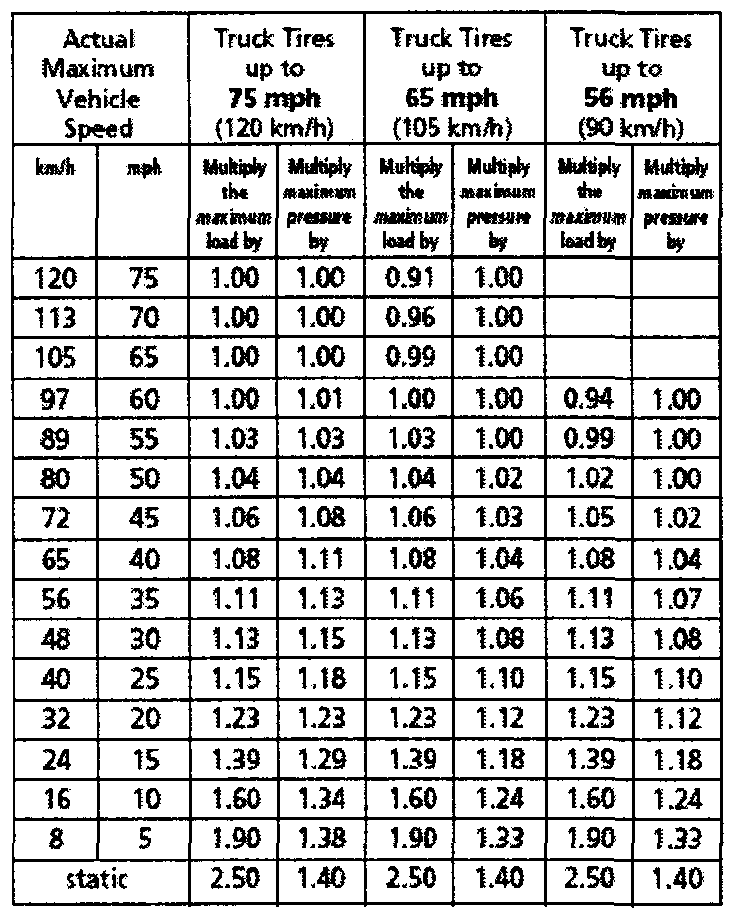 Make it a part of your monthly maintenance routine in a matter of minutes.
Make it a part of your monthly maintenance routine in a matter of minutes.Every editorial product is independently selected, though we may be compensated or receive an affiliate commission if you buy something through our links. Ratings and prices are accurate and items are in stock as of time of publication.
1 / 7
Driving on improperly-inflated tires can wear out the tread and cause steering problems. That’s why it’s important to check your tire pressure regularly.
Fortunately, checking tire pressure only requires two tools — a tire pressure gauge and an air compressor. Most gas stations have an air compressor so you only need to own one tool. The whole process is relatively quick, too. In a matter of minutes you’ve done a lot to ensure a safe and smooth ride.
Before you begin, make sure the car has been parked for three to four hours so you get an accurate reading from the gauge. If you drive to a gas station to use an air compressor, try to find one less than a mile away.
2 / 7
Veronica Graham
3 / 7
Veronica Graham
The driver’s side door jamb typically has a sticker with the recommended PSI (pounds per square inch) for the tires. Most manufacturers recommend 30 to 32 PSI for all four tires, although some cars will have different PSI recommendations for the front tires and back tires. If you don’t see the recommended PSI on your door jamb, check your owner’s manual.
If you don’t see the recommended PSI on your door jamb, check your owner’s manual.
4 / 7
Veronica Graham
Unscrew the cap on the tire air valve and place it somewhere safe.
5 / 7
Veronica Graham
Press the gauge onto the tire air valve straight on, and press it hard. This creates a tight seal around the tire air valve so you don’t accidentally release air from the tire. You’ll hear a hissing sound if air is coming out. A small bar with numbered notches will pop out of the pencil gauge with the tire pressure reading.
6 / 7
Veronica Graham
Fill up the tire by pressing the air compressor nozzle onto the tire air valve in the same manner as the gauge — hard and straight-on to create a tight seal.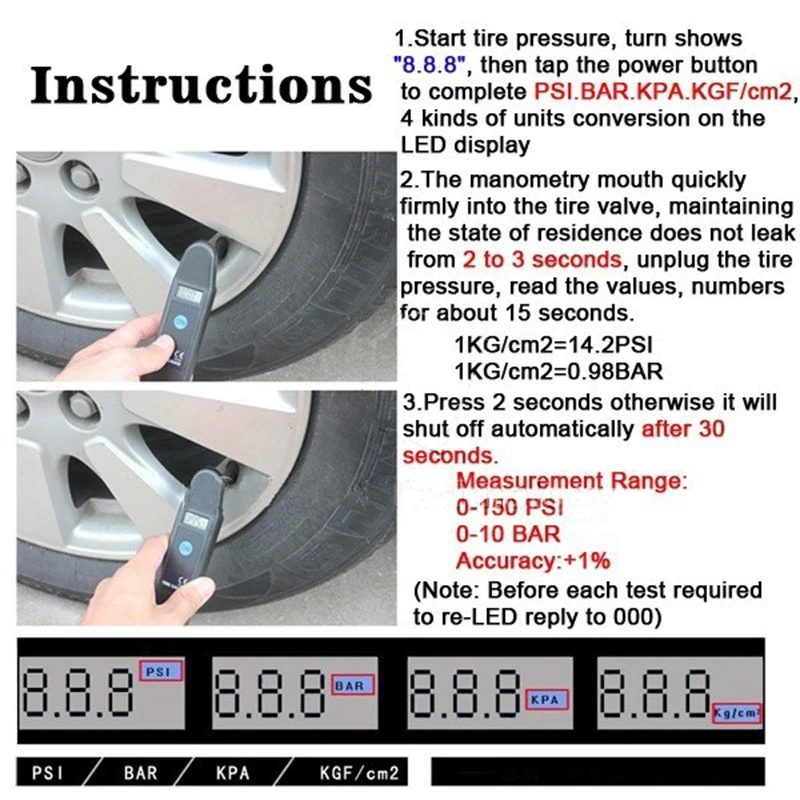 Hold the nozzle onto the tire air valve for about 30 seconds to one minute, depending on how low the initial reading is. Repeat Step Three to get the new reading. Add or release air as needed to reach the recommended PSI.
Hold the nozzle onto the tire air valve for about 30 seconds to one minute, depending on how low the initial reading is. Repeat Step Three to get the new reading. Add or release air as needed to reach the recommended PSI.
7 / 7
Veronica Graham
Repeat Steps Three and Four on the three remaining tires.
Originally Published: April 16, 2020
Veronica Graham
Veronica Graham is a freelance writer in Arlington, Mass. Her work has appeared in The Washington Post and SheKnows. She's covered health, politics, high school football and everything in between. Graham enjoys learning about the world through a variety of lenses as a reporter.
Inconsistency with the prescribed tire pressure leads to a hefty hole in the family budget. Let's figure out how to keep tires in good condition, and what dangers warn the driver.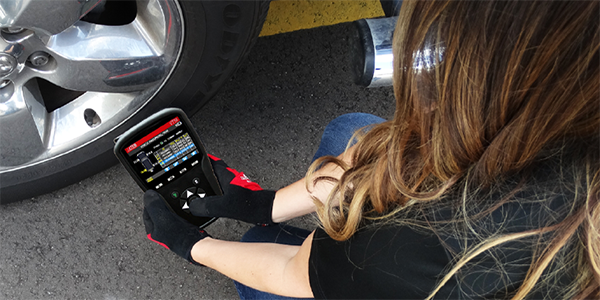
Every year cars require less care from the owner. In the past, before each trip, the driver checked the oil and coolant levels in the engine, thoughtfully kicked the wheels. Those times are gone. Now the car owner calls in for maintenance in a timely manner, and fills in the washer fluid - if the vehicle does not present surprises, then the service ends there. They pay attention to the wheels only during the seasonal change or damage, forgetting that a mismatch in tire pressure can cause increased wear and even an accident!
The manufacturer always indicates the optimal pressure in the tires of passenger cars in the service book. This information is duplicated most often on the door pillar, for some models - on the inside of the gas tank cap or glove compartment. The numbers are clear and understandable. Pressure parameters are indicated corresponding to the allowable tire size at a certain load. Loading is shown by the number of passengers, so even the blonde from the joke can determine the correct value. However, few people follow the wheels. It seems to be not blown away, we will assume that everything is fine!
However, few people follow the wheels. It seems to be not blown away, we will assume that everything is fine!
If the tire is overinflated, its bearing surface becomes convex and there is increased wear in the center of the tire. Friction is slightly reduced and with it fuel consumption when driving on a flat road. But the savings are not justified, because in addition to damage to the tires, handling suffers. When driving at high speed, heating occurs, which is fraught with trouble, up to the explosion of the wheel.
The reverse situation is that there is not enough pressure. The sidewall of the wheel is excessively deformed, the rubber becomes unusable. There were cases when, when hitting an obstacle, the disk was deformed. There is an old "jeeper" trick: when driving off-road, the pressure is released to about 1 atmosphere. In the mud, the wheels begin to work more efficiently. But the pressure will be insufficient, then the rubber breaks off the rim, and fixing tubeless tires in the field is not so easy. When leaving on a good road surface, you need to return the pressure to normal, which requires powerful compressors, the budget ones will push for 20 minutes and overheat.
When leaving on a good road surface, you need to return the pressure to normal, which requires powerful compressors, the budget ones will push for 20 minutes and overheat.
Riding on under-inflated tires is dangerous: both handling and braking dynamics are reduced.
The conclusion is clear - car tire pressure control is needed every two weeks. Mandatory before a long run. Do not forget about the spare wheel, check its condition once a season.
Rule of thumb: pressure is checked on cold tires. When moving, the air heats up, and the pressure increases by 0.2-0.3 bar. If one side of the machine is in the shade and the other is in the sun, uneven heating occurs. It is not so easy to determine the correct adjustments, so in this case it is better to refrain from checking.
The outside temperature is also important. Tires inflated in the summer heat will show insufficient pressure in the fall. In winter, the pressure difference in the wheels of a car standing in a heated garage and on the street reaches 0. 1-0.2 bar. It is clear that the check is carried out where the car drives - directly on the street.
1-0.2 bar. It is clear that the check is carried out where the car drives - directly on the street.
We habitually measure pressure in atmospheres, although bars appear on most pressure gauges produced abroad. Both bars and atmospheres have a dual meaning: physical and meteorological. Today we are interested in the physical.
1 bar = 1 dyne/cm 2 . Ding - a unit of force
In the system of units of the MKGSS, the technical or, as it is also called, the metric atmosphere appears. It is defined as the pressure produced by a force of 1 kgf per square centimeter. 1 atm = 1 kgf/cm 2 .
The difference between bar and technical atmosphere is small: 1 bar = 1.0197 kgf/cm 2 . Such differences do not go beyond the error of a household pressure gauge, so you don’t have to rack your brains on how to measure pressure - in atmospheres or in bars.
In the instructions of some machines may appear psi - pounds per square inch.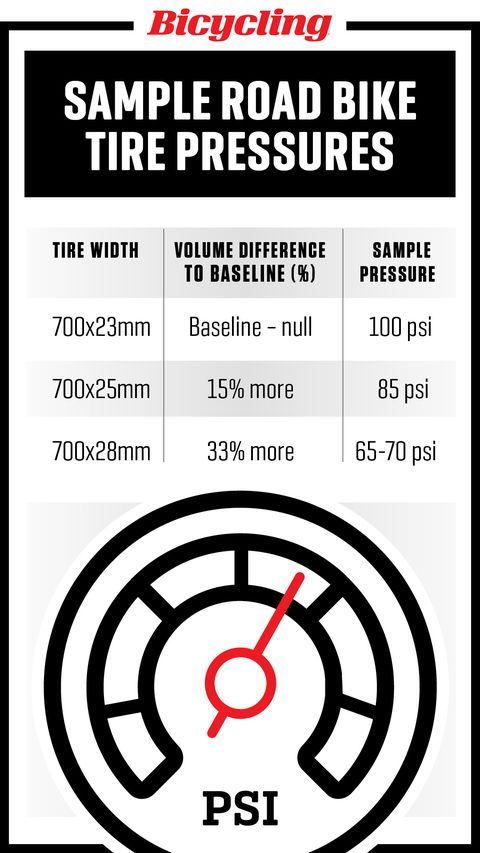 1 atm = 14.2 psi. Translating numbers is troublesome, so it's easier to get a pressure gauge with the right measurement scale.
1 atm = 14.2 psi. Translating numbers is troublesome, so it's easier to get a pressure gauge with the right measurement scale.
It is impossible to determine the pressure in all the wheels of the car by eye. A slight difference from the prescribed one is practically invisible, modern tires hold pressure, even if they catch a nail. It is clear that this pressure is not normal. For example, in a wheel with several nails, 1 atm is stored, which only an experienced driver will feel. So you can't do without a manometer.
Inexpensive compressors are equipped with primitive pressure gauges, on the scale of which it is difficult to see tenths. Therefore, a manual pressure gauge is useful on the farm: it shows the data more accurately and it is easier for them to check the pressure.
Mechanical (pointer) pressure gauges are inexpensive and functional. There are additional buttons for resetting indicators and bleeding air. Usually, 2-3 measurements are made with such equipment, since it is not possible to immediately press the pressure gauge against the tire nipple accurately. Mechanical equipment begins to show incorrect data when moisture enters. Mechanics are less precise than electronics. There is a subspecies of mechanical pressure gauges - rack and pinion. They look like a ballpoint pen, the readings are changed by a cylindrical spring. The thing is fragile, it is not in special demand, and therefore it is little represented in stores.
Usually, 2-3 measurements are made with such equipment, since it is not possible to immediately press the pressure gauge against the tire nipple accurately. Mechanical equipment begins to show incorrect data when moisture enters. Mechanics are less precise than electronics. There is a subspecies of mechanical pressure gauges - rack and pinion. They look like a ballpoint pen, the readings are changed by a cylindrical spring. The thing is fragile, it is not in special demand, and therefore it is little represented in stores.
Electronic pressure gauges rule the roost. They are comfortable, there is a backlight, to switch the measurement scale, just press the button. It would seem - live and rejoice. But such pressure gauges also have disadvantages: they are more expensive than mechanical ones, they fail at low temperatures or refuse to work at all, they suddenly discharge, and they show a significant error when the battery is low.
The purchased pressure gauge is worth checking and comparing its readings with high-quality equipment. To do this, it is enough to call on a good service. Masters of dealerships of FAVORIT MOTORS Group during scheduled maintenance of the car without fail check the tire pressure, examine the wear of rubber. If deficiencies are identified, they are eliminated in a short time.
To do this, it is enough to call on a good service. Masters of dealerships of FAVORIT MOTORS Group during scheduled maintenance of the car without fail check the tire pressure, examine the wear of rubber. If deficiencies are identified, they are eliminated in a short time.
Photo: Shutterstock
adv.rbc.ru
See also
Tires are the only vehicle element that is in constant contact with the road. One of the main indicators of their serviceability is pressure. It affects not only fuel efficiency, but also safety.
As a rule, car manufacturers recommend maintaining tire pressures between 2.0 and 2.8 bar. But in practice there are situations when it is necessary to deviate from this norm.
adv.rbc.ru
Tire pressure should be checked at least once a month, there are several ways to do this. We understand why it is so important to observe the optimal pressure indicator and what it affects.
In this story:
Tire pressure is the resistance with which air "presses" on the inner area of the rubber. Properly inflated tires will last longer, give you better ride quality and improve your driving safety. If the pressure in the tires is too low or they are pumped over, then the car owner runs the risk of facing a number of problems: from buying new tires to the threat of an accident.
Properly inflated tires will last longer (Photo: Global Look Press)
Under-inflated tires are tires that are below the recommended pressure. In this case, the contact patch of rubber with the road increases, which leads to increased friction or rolling resistance. A worn out outer edge of the tread can visually give out such a problem.
In this case, the contact patch of rubber with the road increases, which leads to increased friction or rolling resistance. A worn out outer edge of the tread can visually give out such a problem.
Increased friction with the road can cause the tire to overheat, slip and even burst. In addition, low tire pressure leads:
When tires are over-inflated, that is, above the manufacturer's recommended rate, the contact patch decreases. As a result, the main friction with the road is taken over by the central part of the tire.
Excessive tire pressure leads to excessive sensitivity to road irregularities and the risk of tire damage, even destruction. Overinflated tires also cause the following:

Tatyana Eliseeva, an auto expert, international master of sports in motorsport, comments
For flat tires:
For overinflated tires:
Excessive tire pressure leads to excessive sensitivity to road irregularities and the risk of tire damage (Photo: Shutterstock)
For each car model, the manufacturer sets its own optimal tire pressure. This indicator depends on the mass of the car, the speed of operation, the number of passengers (partial or full boarding), as well as the load on the trunk [1].
This indicator depends on the mass of the car, the speed of operation, the number of passengers (partial or full boarding), as well as the load on the trunk [1].
The recommended tire pressure can be found in the vehicle owner's manual or on one of the plates/stickers in the passenger compartment. They can be:
Tire pressure is measured in several units. In Russia, they usually indicate in kg / cm 2 (or atmospheres) and bars (bar). These two indicators are almost equal, which is why they are often used as synonyms:
Foreign models often use pounds per square inch (pound per square inch), or psi:
For convenience, car manufacturers can indicate pressure in two units at once - bar and psi. Thus, the need to independently calculate according to the formulas disappears. Otherwise, you can do this in one of the online calculators or check the table of popular values.
Thus, the need to independently calculate according to the formulas disappears. Otherwise, you can do this in one of the online calculators or check the table of popular values.
| 2.0 bar | 2.1 bar | 2.2 bar | 2.3 bar | 2.4 bar | 2.5 bar | 2.6 bar | 2.7 bar | 2.8 bar |
| 29psi | 30psi | 32 psi | 33 psi | 35 psi | 36 psi | 38 psi | 39psi | 41 psi |
Temperature has a significant effect on tire pressure: when it drops, the pressure in the wheels decreases with it. When the temperature drops by 10 °C, the tire deflates by an average of 0.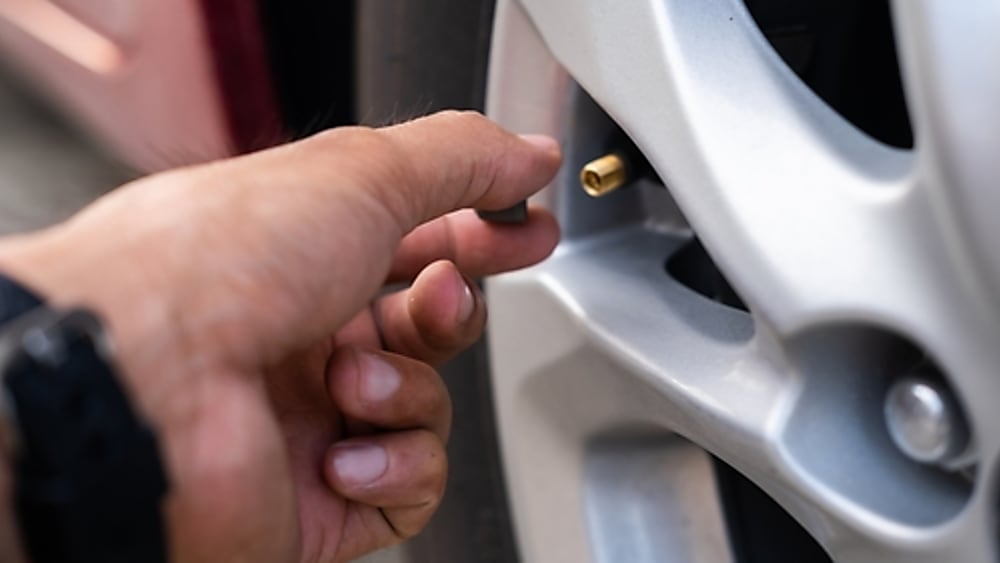 07–0.14 bar or 1 to 2 psi [2].
07–0.14 bar or 1 to 2 psi [2].
Temperature has a significant effect on tire pressure (Photo: Shutterstock)
Summer tires typically use manufacturer's recommended readings. But in winter, it is advised to add about 0.2 bar to these figures [3].
Experts also recommend checking and correcting tire pressure at outside temperature. In the cold season, swapping is best done not in a warm garage, but on the street. In summer, before such a manipulation, you should make sure that some of the wheels of the car were not under the scorching sun, while others were in the shade.
Sometimes the tire pressure needs to be adjusted according to the situation. For example, when the machine is fully loaded or a trailer is towed. For such cases, automakers, as a rule, separately indicate the optimal pressure.
But there are moments that fall into the category of extreme and non-standard (especially if before that the car most often drove around the city).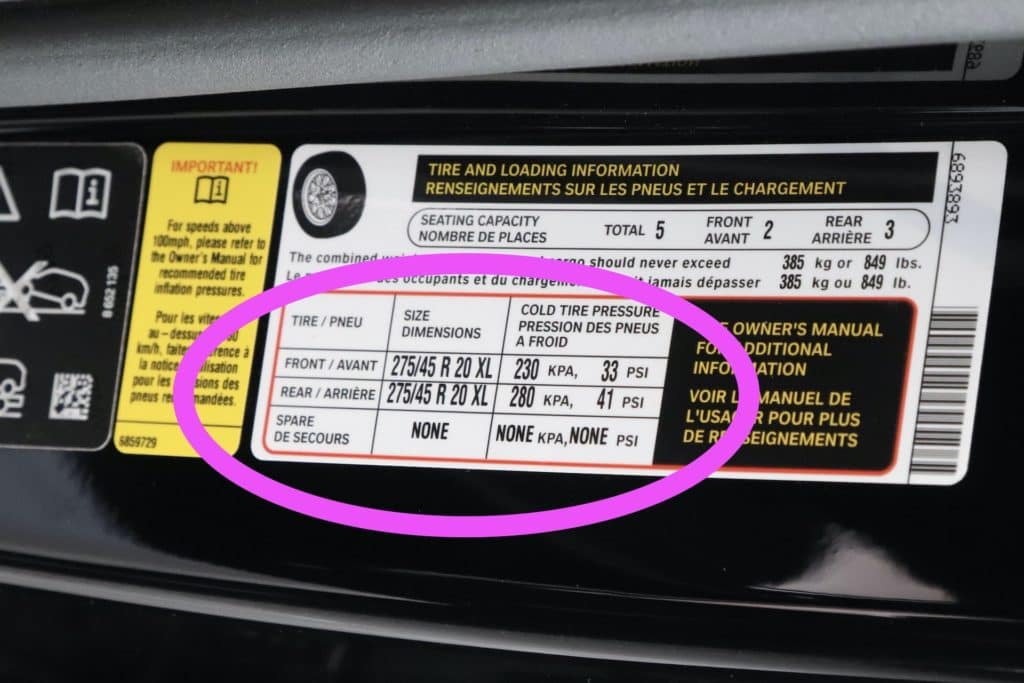 Automotive expert Tatyana Eliseeva analyzed the most common of them.
Automotive expert Tatyana Eliseeva analyzed the most common of them.
Leads to heating of the wheels, especially in summer, and therefore it is necessary to follow the manufacturer's recommendations before such a trip. We do not know what we will meet: patched road repairs or heavy rain. After all, for each of these situations, the recommendations will be opposite. Athletes can play with pressure when track conditions are known and engineers can always change the settings. For a long journey, the layman just needs to choose the average.
Tires must be bled off, especially on sand. The question is for how much? You can bleed up to 0.7 atm, but a not very experienced motorist can slip the wheels with an inaccurate movement, and if the driver turns the steering wheel sharply (for example, trying to catch on the edge of the track), then the tire can come off the disk. And such cases occur regularly.
At near-zero temperatures on packed snow, ice or sludge for new wheels (velcro or studded) it is better to pump the wheels a little so that water and sludge are squeezed out of the central zone of the contact patch and the tread is better worked. The wheel must be cleared for the tread to work. When it is clogged with snow, the braking distance and traction deteriorate greatly.
The wheel must be cleared for the tread to work. When it is clogged with snow, the braking distance and traction deteriorate greatly.
If the car has worn wheels, but with an acceptable tread depth for winter tires (4 mm), then you should not hope for the correct operation of the tread. Such a low checker no longer pushes the snow. In this case, it is necessary to reduce the pressure in the wheel, thereby increasing the same contact patch.
Photo: Global Look Press
On a country road, the weight of the machine will be an important factor. In this case, we select the pressure according to the load - specific indicators must be viewed on the central pillar of the body. There you will see something like the following recommendation: the more the car is loaded, the higher the pressure in the rear wheels should be.
But a badly broken road can lead to herniations, ruptures and tire damage. Therefore, if we increase the pressure, then we drive on a bad road as calmly and measuredly as possible.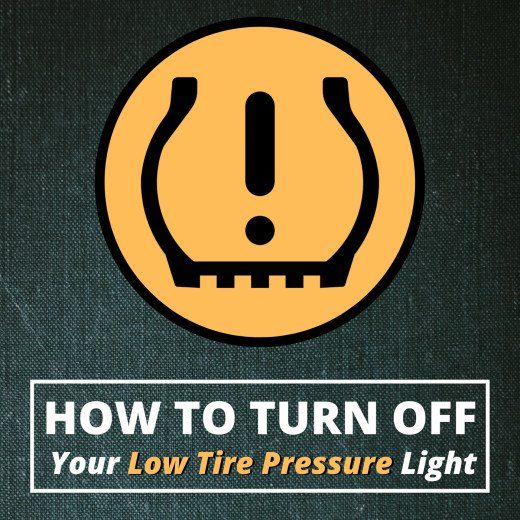 Or we slightly deviate from the manufacturer's recommendations and raise the pressure not as much as the manufacturer recommends.
Or we slightly deviate from the manufacturer's recommendations and raise the pressure not as much as the manufacturer recommends.
The main factor in changing the behavior of the wheel is not the pressure drop at altitude, but the presence of a large number of sharp turns and long braking. The tire will heat up not only from the loads, but also from the operation of the brake mechanisms. Therefore, the idea that due to low pressure it is necessary to increase the pressure in the tires is wrong, because the temperature of the wheel has a much greater influence in this case.
The recommended pressure is always given when the tires are cold. This means that the vehicle has not been driven for three hours or has traveled less than 1 mile (or one mile).
There are two ways to check tire pressure: on your own or at a workshop. In the first case, it is enough to use a public pump at a gas station or purchase a pressure gauge. This tire pressure measuring device comes in three types:
This tire pressure measuring device comes in three types:
Another option is to install special pressure control caps on each nipple. Such a gadget works as follows: the upper part of the cap is transparent and, depending on the level of pressure, an indicator of three colors appears in it. Green - the pressure is normal, yellow - the tire is flat, red - the pressure has exceeded the norm.
Photo: Shutterstock
The easiest way to monitor tire pressure is with the automatic TPMS (Tire Pressure Monitor System). Today it is installed on almost all models, and in some countries its presence is a prerequisite for releasing a car from the assembly line.
In these systems, the electronics automatically detect changes in the tire, and if the pressure drops below the recommended value, a warning signal lights up on the on-board computer screen.
There are two types of TPMS:
Car manufacturers recommend checking tire pressure every two weeks, but at least once a month. Indeed, even under ideal conditions (for example, the car is idle for a long time), the wheels lose approximately 0.069bar, or 1 psi, per month [4].
The pressure should be monitored before and after a long trip, during a sudden change in temperature (for example, during the first frost or warming), and also after changing tires or driving with a load.